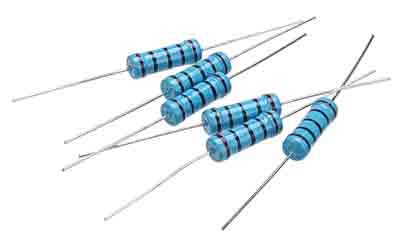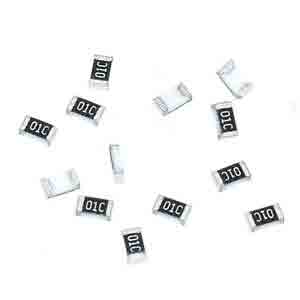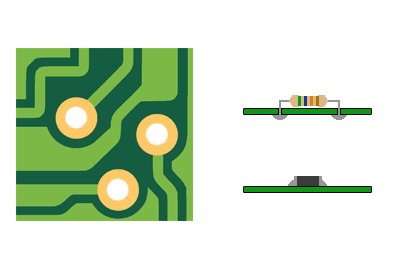We continue with our PCB design tutorial section, looking at PTH and SMD components, their differences, as well as the advantages and disadvantages of each technology.
In previous posts, we have already seen what a PCB is, what its parts are, what layers are, the importance of vias, and briefly presented the manufacturing process of a PCB.
At this point, we should be losing “the fear” of the PCB concept, and it should be clear that a PCB is nothing more than a simple, cheap, and compact way to replace the wiring of an electronic circuit.
In addition to the PCB, we must add the electronic components themselves. Together, the conductor tracks of the PCB and the components make up the designed electronic circuit.
Now that we have introduced PCBs, it’s time to talk about electronic components. As we had already mentioned, there are two major families of components: PTH and SMD, depending on how they are mounted on the PCB.

You will also see them referred to as THT (Through Hole Technology) and SMT (Surface Mounted Technology)
PTH components (plated-through holes) are mounted by inserting them into perforations in the PCB where the conductor is left exposed around the perimeter, and then they are soldered.

You are probably used to this type of components. They are the ones most frequently found when learning electronics, or in household appliances, as they are the components used in a breadboard.
On the other hand, SMD components (Surface Mounted Device) are mounted on the surface of the PCB, without the need for perforation. For this, areas of exposed conductor are left, which, as we saw, are called pads.

You have probably seen SMD components many times as well. Every time you disassemble a commercial device, most of the components you will find are SMD.
PTH and SMD Advantages
Of course, each component technology has its own advantages and disadvantages. Otherwise, one would simply have completely replaced the other.
So let’s briefly look at the advantages of each of them, and when it is appropriate to use them.
PTH Advantages
The advantages of PTH are as follows.
- Much easier to solder manually
- Can be used on a breadboard
- Generally stronger and more resistant than SMDs
So, in general, it is convenient to use PTH in PCB designs soldered by hand or for small productions, because they are much simpler to handle and solder.
However, PTH technology is also used in components that require greater mechanical resistance, such as connectors or heavy components, or those with heat dissipation requirements.
SMD Advantages
On the other hand, we could summarize the advantages of SMD components as,
- Smaller and cheaper
- Easier to mount by a machine
- Some integrated circuits are only available in SMD
Therefore, SMD components are usually the preferred option for industrial assemblies, due to their lower cost and size, and because they are more easily manufacturable in quantity.
Also, logically, they will be the only viable option when we need a specific component that does not exist in PTH technology. This usually also coincides with advanced PCB designs, since “basic” components exist in both technologies.
Conclusion
We have seen both families of components, PTH and SMD. We have seen that, in summary, PTH components are easier to handle by hand, while SMD components are smaller and cheaper.
The advice is that you start in the world of electronics with PTH components, because they are easier to solder. In addition, you can test the circuit on a breadboard, or even solder it on a protoboard.
But if you get into the world of PCBs, as soon as possible, switch to SMD technology. In the end, the larger SMD sizes, which we will see in the next post, are not so difficult to solder by hand. Your circuits will be much more professional, smaller, and cheaper.
That’s it for this introduction to components post. In the next post, we will give a brief overview of some of the electronic components that we will commonly encounter when designing PCBs.
And you, do you prefer PTH or SMD components? If you feel like sharing your opinion, you can leave us a comment!
